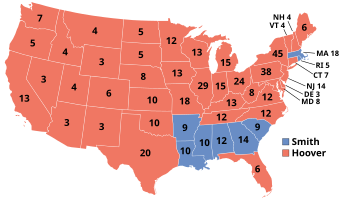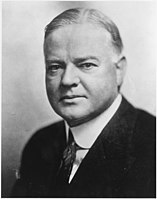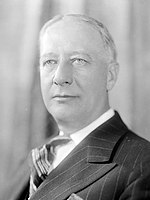
Back انتخابات الرئاسة الأمريكية 1928 Arabic ھەڵبژاردنی سەرۆکایەتیی ویلایەتە یەکگرتووەکانی ئەمریکا (١٩٢٨) CKB Præsidentvalget i USA 1928 Danish Präsidentschaftswahl in den Vereinigten Staaten 1928 German Elecciones presidenciales de Estados Unidos de 1928 Spanish انتخابات ریاستجمهوری ایالات متحده آمریکا (۱۹۲۸) Persian Yhdysvaltain presidentinvaalit 1928 Finnish Élection présidentielle américaine de 1928 French הבחירות לנשיאות ארצות הברית 1928 HE ԱՄՆ նախագահական ընտրություններ 1928 Armenian
| |||||||||||||||||||||||||||||
531 members of the Electoral College 266 electoral votes needed to win | |||||||||||||||||||||||||||||
|---|---|---|---|---|---|---|---|---|---|---|---|---|---|---|---|---|---|---|---|---|---|---|---|---|---|---|---|---|---|
| Turnout | 56.9%[1] | ||||||||||||||||||||||||||||
| |||||||||||||||||||||||||||||
 Presidential election results map. Red denotes states won by Hoover/Curtis, blue denotes those won by Smith/Robinson. Numbers indicate the number of electoral votes allotted to each state. | |||||||||||||||||||||||||||||
| |||||||||||||||||||||||||||||
Presidential elections were held in the United States on November 6, 1928. Republican former Secretary of Commerce Herbert Hoover defeated the Democratic nominee, Governor Al Smith of New York. After President Calvin Coolidge declined to seek reelection, Hoover emerged as the Republican party's frontrunner. As Hoover's party opponents failed to unite around a candidate, Hoover received a large majority of the vote at the 1928 Republican National Convention. The strong state of the economy discouraged some Democrats from running, and Smith was nominated on the first ballot of the 1928 Democratic National Convention. Hoover and Smith had been widely known as potential presidential candidates long before the 1928 campaign, and both were generally regarded as outstanding leaders. Both were newcomers to the presidential race and presented in their person and record an appeal of unknown potency to the electorate. Both faced serious discontent within their respective parties' membership, and both lacked the wholehearted support of their parties' organization.[2]

In the end, the Republicans were identified with the booming economy of the 1920s, and Smith, a Roman Catholic, suffered politically from anti-Catholic sentiment particularly in the Solid South, his opposition to Prohibition, and his association with the legacy of corruption by Tammany Hall. Hoover won a third straight Republican landslide and made substantial inroads in the traditionally-Democratic Solid South by winning several states that had not voted for a Republican since the end of Reconstruction. Smith carried the five states of the Deep South, his running mate's home state of Arkansas, and the Northeastern states of Massachusetts and Rhode Island.
Hoover's victory made him the first president born west of the Mississippi River, and he is the most recent former member of the Cabinet to win a presidential election. Charles Curtis was elected vice president, becoming the first Native American and the first person with acknowledged non-European ancestry to reach that office, a feat that was not repeated until 2021, when Kamala Harris became vice president under President Joe Biden. Hoover would be the last Republican to win a presidential election until 1952, when Dwight D. Eisenhower defeated Democratic nominee Adlai Stevenson II. As of 2024 this remains the last time a party was elected to two consecutive terms without the nominee being the incumbent or the former vice president.
- ^ "National General Election VEP Turnout Rates, 1789-Present". United States Election Project. CQ Press.
- ^ The Presidential Vote, 1896–1932, Edgar E. Robinson, pg. 24

